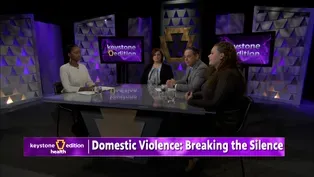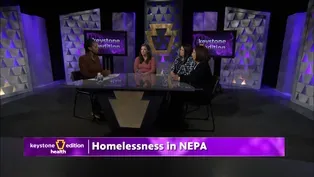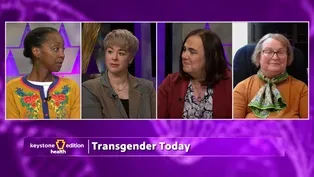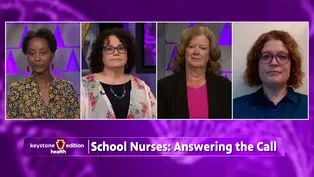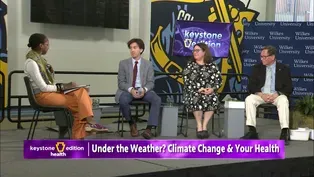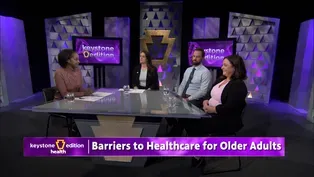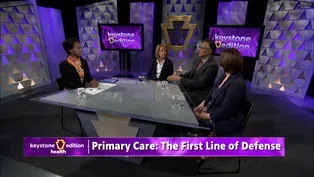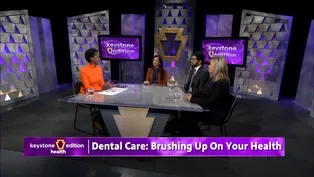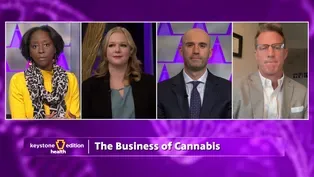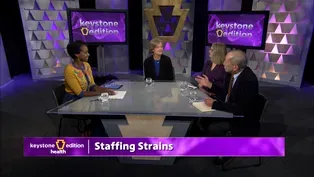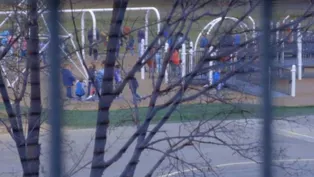Keystone Edition
In Sickness and in Play: Chronic Disease in Children
1/22/2024 | 27mVideo has Closed Captions
About 25% of children in the US aged 2 to 8 years have a chronic health condition
Chronic refers to a health condition that lasts anywhere from three months to a lifetime. Chronic illness entails frequent physician visits and medical leaves requiring the child or adolescent to miss classes and school activities. This can increase the child's loneliness and feeling of being different from other youngsters.
Problems with Closed Captions? Closed Captioning Feedback
Problems with Closed Captions? Closed Captioning Feedback
Keystone Edition is a local public television program presented by WVIA
Keystone Edition
In Sickness and in Play: Chronic Disease in Children
1/22/2024 | 27mVideo has Closed Captions
Chronic refers to a health condition that lasts anywhere from three months to a lifetime. Chronic illness entails frequent physician visits and medical leaves requiring the child or adolescent to miss classes and school activities. This can increase the child's loneliness and feeling of being different from other youngsters.
Problems with Closed Captions? Closed Captioning Feedback
How to Watch Keystone Edition
Keystone Edition is available to stream on pbs.org and the free PBS App, available on iPhone, Apple TV, Android TV, Android smartphones, Amazon Fire TV, Amazon Fire Tablet, Roku, Samsung Smart TV, and Vizio.
Providing Support for PBS.org
Learn Moreabout PBS online sponsorshipMore from This Collection
Domestic Violence: Breaking the Silence
Video has Closed Captions
Access to the right resources can make facing this challenge a little easier for families (26m 59s)
Video has Closed Captions
Homelessness can happen to anyone at any age or socio-economic status. (26m 59s)
Video has Closed Captions
As we raise the visibility on Transgender young adults and embrace them within our culture (26m 59s)
Video has Closed Captions
Obesity is a serious risk factor many try to avoid when developing healthy eating habits. (27m)
School Nurses: Answering the Call
Video has Closed Captions
What can our school districts do to help retain and recruit nurses for future generations? (27m)
Under the Weather? Climate Change & Your Health
Video has Closed Captions
How does climate change impact individual and public health? (54m 59s)
Barriers to Healthcare of Older Adults
Video has Closed Captions
What progress have local organizations made in addressing these challenges? (27m)
Primary Care: The First Line of Defense
Video has Closed Captions
When was the last time you saw your primary care doctor? (27m)
The Smallest Victims: Child Abuse & Trafficking
Video has Closed Captions
What are the signs to know to spot child abuse and even possible trafficking? (27m)
Dental Care: Brushing Up on Your Health
Video has Closed Captions
How can providers make dental care more affordable and accessible? (26m 59s)
Video has Closed Captions
What does the cannabis industry mean for Northeastern and Central Pennsylvania? (26m 59s)
Video has Closed Captions
Low staffing levels can lead to burnout among healthcare workers (27m)
Providing Support for PBS.org
Learn Moreabout PBS online sponsorshipLive from your public media studios, WVIA presents studios, WVIA presents Keystone Addition Health, a Keystone Addition Health, a public affairs program that public affairs program that goes beyond the headlines goes beyond the headlines to address issues in to address issues in North-Eastern in central North-Eastern in central pencil.
Thania.
This is pencil.
Thania.
This is Keystone.
In addition, Keystone.
In addition, health and now moderator health and now moderator Tanya Verkitus.
Good Tanya Verkitus.
Good evening and welcome to evening and welcome to Keystone.
In addition, Keystone.
In addition, health, anti-gay Verkitus.
health, anti-gay Verkitus.
Thank you for joining us Thank you for joining us tonight.
We're going to be tonight.
We're going to be discussing a topic that discussing a topic that often goes unnoticed.
The often goes unnoticed.
The impact of chronic diseases impact of chronic diseases on our children.
the on our children.
the conditions we will be going conditions we will be going over tonight require over tonight require ongoing medical attention, ongoing medical attention, often affecting the often affecting the individual's day to day individual's day to day lives.
We'll be hearing lives.
We'll be hearing many different stories, many different stories, statistics and know what statistics and know what the signs are to look for.
the signs are to look for.
And the children that face And the children that face these issues.
But first, these issues.
But first, WRVO EHS Tom Reese has more chronic diseases in chronic diseases in children pose a significant children pose a significant and challenging health and challenging health concern globally.
These concern globally.
These conditions lasting for an conditions lasting for an extended period, can impact extended period, can impact the child's overall the child's overall well-being and development.
well-being and development.
According to an article According to an article from the Child Mind from the Child Mind Institute, chronic medical Institute, chronic medical illnesses can disrupt illnesses can disrupt school friendships, extra school friendships, extra curricular and social curricular and social activities as well as activities as well as normal emotional and normal emotional and psychological development.
psychological development.
The prevalence of chronic The prevalence of chronic diseases in children has diseases in children has been on the rise, been on the rise, necessitating increase necessitating increase attention from health care attention from health care providers, educators and providers, educators and parents managing these parents managing these conditions often requires a conditions often requires a comprehensive approach comprehensive approach involving medical involving medical treatments, lifestyle treatments, lifestyle modification and emotional modification and emotional support.
to ensure optimal support.
to ensure optimal quality of life for quality of life for affected children.
Keystone affected children.
Keystone additions, health.
I'm Tom additions, health.
I'm Tom Reese, WVIA News joining us tonight.
We have joining us tonight.
We have Julia Roberts, president Julia Roberts, president and CEO from us from Attala and CEO from us from Attala JPC, Ma as Salaam Child and JPC, Ma as Salaam Child and Adolescent Psychiatry Adolescent Psychiatry interests from Friendship interests from Friendship House and Timothy Wellby.
House and Timothy Wellby.
Apart here at pediatrics of Apart here at pediatrics of North eastern Pennsylvania, North eastern Pennsylvania, Thank you for joining us Thank you for joining us tonight.
I'm actually going tonight.
I'm actually going to start with you, Dr. to start with you, Dr. Wellby.
You've been a Wellby.
You've been a pediatrician for quite some pediatrician for quite some time.
In the intro, they time.
In the intro, they mentioned that chronic mentioned that chronic diseases, illnesses are on diseases, illnesses are on the rise.
Do you feel that the rise.
Do you feel that there has been a change in there has been a change in the amount of illness and the amount of illness and disease you've seen in disease you've seen in children who will children who will absolutely right over the absolutely right over the course of my career.
I course of my career.
I can't give you exact can't give you exact numbers, but I can numbers, but I can certainly tell you that certainly tell you that chronic illnesses in chronic illnesses in children and adolescents children and adolescents are certainly on the rise.
are certainly on the rise.
Some are things that we've Some are things that we've seen for many years, and seen for many years, and some of them are newer and some of them are newer and some of them have been some of them have been exacerbated by the pandemic exacerbated by the pandemic You know, that that has You know, that that has caused some some things caused some some things that we've always had to that we've always had to get worse and and more get worse and and more serious and more common.
serious and more common.
And so wherever you look.
And so wherever you look.
Chronic disease in children Chronic disease in children is increasing.
And would is increasing.
And would you say that some of the you say that some of the covert effects have to do covert effects have to do with mental health, primary with mental health, primary or just disease in general?
or just disease in general?
The disease in general?
The disease in general?
Illnesses sick all winter Illnesses sick all winter and all of that went down and all of that went down quite a bit.
Right.
Because quite a bit.
Right.
Because kids weren't in school and kids weren't in school and weren't around other kids, weren't around other kids, which was the idea at the which was the idea at the time.
But it has really time.
But it has really caused some some mental caused some some mental health issues.
And it's health issues.
And it's exacerbated mental health exacerbated mental health problems.
anxiety and problems.
anxiety and depression in school depression in school children and adolescents.
children and adolescents.
That is certainly on the That is certainly on the rise percentage wise.
And rise percentage wise.
And the other thing, the other thing, unfortunately, you know, unfortunately, you know, you see it across United you see it across United States, the obesity and States, the obesity and overweight epidemic in overweight epidemic in children is markedly worse children is markedly worse after the pandemic because after the pandemic because that was years of you're that was years of you're not going to gym class, not going to gym class, you're not go into sports, you're not go into sports, you know.
And even as the you know.
And even as the pandemic's eased, people pandemic's eased, people don't want their kids out don't want their kids out as much as they used to.
So as much as they used to.
So that's a big problem.
that's a big problem.
Doctors, Latin, you Doctors, Latin, you obviously are working with obviously are working with children who are children who are experiencing mental health experiencing mental health issues.
Have you noticed a issues.
Have you noticed a change as well?
Just since change as well?
Just since the pandemic, but since you the pandemic, but since you started doing this work, started doing this work, Yes.
So I agree with Dr.
Yes.
So I agree with Dr. Robi.
There has been Robi.
There has been increase and the diagnosis increase and the diagnosis and the treatment actually and the treatment actually are far chronic diseases, are far chronic diseases, physical and mental.
But physical and mental.
But definitely after the definitely after the pandemic, there has been an pandemic, there has been an extreme early increase in extreme early increase in Alexeyeva.
I would say in Alexeyeva.
I would say in depression and it's taking depression and it's taking a toll on the family as a toll on the family as well.
And I see a lot of well.
And I see a lot of kids that have been like kids that have been like shifting towards like cyber shifting towards like cyber or online learning and sort or online learning and sort of like doing going to of like doing going to school.
It's just life school.
It's just life changing.
really.
After the changing.
really.
After the pandemic.
Also, just tell pandemic.
Also, just tell us a little bit about us a little bit about Friendship House.
I know Friendship House.
I know you work with children, but you work with children, but do you also work?
Yes.
Yes.
do you also work?
Yes.
Yes.
So so we provide actually, So so we provide actually, like quite comprehensive like quite comprehensive treatment for children and treatment for children and adults.
We have outpatient adults.
We have outpatient clinics.
We have four clinics.
We have four children.
We have a school children.
We have a school based behavior, health based behavior, health teams and the school's we teams and the school's we have family home based have family home based services that is in the services that is in the home for adts.
We have home for adults.
We have outpatient clinics and we outpatient clinics and we have the rehab programs.
have the rehab programs.
It's called psych rehab It's called psych rehab program.
And we are program.
And we are actually expanding and we actually expanding and we might have substance use might have substance use program as well for adults.
program as well for adults.
Dr. Roberts, you don't see Dr. Roberts, you don't see as many children as Dr. as many children as Dr. Welby might like.
You're Welby might like.
You're seeing people as they are seeing people as they are transition to adulthood.
transition to adulthood.
But are you finding that But are you finding that you have more teenagers coming to see that you did previously?
I mean, we do see a fair amountf teenars, a where I come in ishe transitn from teene tir graduathigh schoo Theth have to ty Thethey havto they sll have is chronic someby.
And unftunately n rheumatogy, there a vy, very signicantn rheumalogya shortage s maybewo or three for pediaice Hersh Temple, Hopp,s t areas thaI treat.
S someonn thereas that treat.
So , I see e chdrenI do , I see e children.
do the bodrk thawe feel rumatologist then get tsee a rheumatogist in t larger ties that ve the larger ties that ha the rumatologistsBut I get tsee a tnk as a foowing up ith their mments is at witthr commen is that not onlye of thesconditio, but not onlye of thesconditionsbutt not onlye we' seeing mo t e're seeg mo the recogniti of te onditions.ouno wre seeing y sayingwell, we seeing sasaying, well, we have post covered in have po covered i children, but we'reeeing these, you know, thes childn that are younow, they're noteeling so good A all of a sudden, they And all of sudden, they read something in the read something inhe Internet and and they'r Internet and and they're coming.
But they really coming.
But ty really have something.
And you have something.
And you the kids, you know, these kids, you know, they've been smolt and they' been smolt and smolder.
All of sudden they're seeing now I haveder.
n they're seeing now I have something thaI can peg something thaI can peg into this.
And en now into this.
And then now they have thikind of they have this kind of condition.
So you're saying condition.
So you're saying the that Dr. Google can be trusted?
I n't think it's trusted?
I n't think it's a bad things long as it's a bad thing as long as it's used judicious.
So if if so I don't a problem wit somebody coming and say, somebody coming and s, well, I read this.
Well, well, I read this.
We, let's now.
Now, with that let's now.
Now, with that knowledge that you have, knowledge that you have, let's put my comments let's put my comments together, maybe we can come together, maybe we can come up with an answer that's up with an answer that's apppriate and treatable appropriate and treatable sometimes.
I'd ke to talk sometim.
I'd like to talk a little bit about the a little bit about the amount of time care takes amount of time care takes for children with chronic disease.
You probly see this quite a bit because this quite a bit because they're coming to see you they're coming to see you every now and but then every now a but then there's the specialists, et there's the specialists, et cetera, Can you paint a picture for us?
You know, there's there the actual there's there's the actual medical care where they medical care where they come and see me and they come and see me and they get diagnosed.
But then et diagnosed.
But then there's the you've got to go for lab work.
Maybyou need to go out of town to need to go out of town to see a specialist.
Maybe you see a specialist.
Maybe you need physical therapy.
need physical therapy.
occupational therapy, occupational therapy, something that you have a something that you have a room or a logic problem and room or a logic problem and you're gonna have to go to you're gonna have to go to beat Peaty a couple of beat Peaty a couple of times a month or even a times month or even a couple of times a week.
So couple of times a week.
So kids with chronic illness, kids with chronic illness, they've got not just come they've got not just come into my office, but they've into my office, but they've got to go get lab work and got to go get lab work and get testing and see get testing and see specialists and specialists and unfortunately, a lot of unfortunately, a lot of pediatric specialists are pediatric specialists are out of town.
You've got to out of town.
You've got to go to Danville.
You've got go to Danville.
You've got to go to Philly.
or Hershey to go to Philly.
or Hershey So there's that travel on So there's that travel on top of of going to see the top of of going to see the specialist, which is hard specialist, which is hard on a child, but hard on the on a child, but hard on the family.
Right.
That's a lot family.
Right.
That's a lot of time and oftentimes a of time and oftentimes a lot expense said that's not lot expense said that's not that easy.
Doctors along.
that easy.
Doctors along.
How is this affecting How is this affecting mentally if they have mentally if they have chronic disease?
It's so chronic disease?
It's so definitely the chronic definitely the chronic disease has that can impact disease has that can impact on the mental health, the on the mental health, the emotional and behavioral emotional and behavioral well-being of the child.
well-being of the child.
and the family as well.
And and the family as well.
And I would say, like we we try I would say, like we we try to help get them to cope.
to help get them to cope.
Rig.
That's the that's Right.
That's the that's the basically the the the basically the the message is how how can we message is how how can we cope with them, with cope with them, with chronic illness, either chronic illness, either mental or physical and how mental or physical and how to train the family to cope to train the family to cope as well.
I think this the as well.
I think this the most important is to help most important is to help at the family school at the family school because the kids are well, because the kids are well, well, MARER, they're well, MARER, they're parents raise.
So if the parents raise.
So if the parents are able to call parents are able to call paid like really healthy paid like really healthy cope because sometimes that cope because sometimes that the hope can be unhealthy.
the hope can be unhealthy.
So how to to train them to So how to to train them to to to to actually try to to to to actually try to manage though first of all, manage though first of all, the news of the chronic the news of the chronic right there, the initial right there, the initial phase of the chronic phase of the chronic illness and then how to illness and then how to actually go through the actually go through the whole process until the whole process until the recovery.
There's there's recovery.
There's there's the stages of the chronic the stages of the chronic mental or physical health.
mental or physical health.
So when they come and see So when they come and see me, I would not say me, I would not say specifically the well, come specifically the well, come to see me from Dr. Robi to see me from Dr. Robi because they have like a because they have like a chronic medical condition.
chronic medical condition.
But I think once he sees, But I think once he sees, like, sir and like like, sir and like concerning kind of symptoms like disruptive behaviors like disruptive behaviors in a school, they are like in a school, they are like oppositional, defiant.
They oppositional, defiant.
They will make their will make their recommendation to go and recommendation to go and see a car, child see a car, child psychiatrist, and then we psychiatrist, and then we take it from there and see take it from there and see if we can help.
There was if we can help.
There was mention of pediatrics mention of pediatrics special.
If there is not special.
If there is not that many in the area, how that many in the area, how do they get referred to do they get referred to these folks?
And then is it these folks?
And then is it just you just have to go to just you just have to go to Danville every week?
Well, Danville every week?
Well, I'll tell you what happens.
I'll tell you what happens.
You heathe call, they'll You hear the call, they'll call me Pouliot.
Do you call me Pouliot.
Do you mind seeing this nine year mind seeing this nine year old call?
Well, I'll I'll old call?
Well, I'll I'll see them, but I can call see them, but I can call somebody that can see them.
somebody that can see them.
So there's there's the So there's there's the connections and and the connections and and the connection that we have connection that we have with the providers.
So and with the providers.
So and I can tell you that for the I can tell you that for the most part, these providers most part, these providers will pick up the phone, we will pick up the phone, we call them and say, well, call them and say, well, you know, this is what they you know, this is what they have.
And you might not have.
And you might not have them wait six months.
have them wait six months.
Can we see them?
And Can we see them?
And they'll bring them in they'll bring them in sooner.
But that's a big sooner.
But that's a big hurdle because it's not hurdle because it's not only something that affects only something that affects the child, the parent, but the child, the parent, but you're looking at, you know you're looking at, you know this child has a chronic this child has a chronic disease, may have a brother disease, may have a brother and sister.
So that takes and sister.
So that takes time from the minute, time from the minute, impacts the whole family, impacts the whole family, not just that child.
So not just that child.
So you'll see that a lot.
And you'll see that a lot.
And what do you tell the what do you tell the families?
Happy.
You tell families?
Happy.
You tell them to prepare?
You know, it depends on how severe the illness is.
The disease the illness is.
The disease is.
And where they have to is.
And where they have to go.
And, you know, our go.
And, you know, our office tries to be very office tries to be very helpful.
Here's where your helpful.
Here's where your insurance will let you go.
insurance will let you go.
Here's where the best Here's where the best specialists are.
Here's specialists are.
Here's where I'm comfortable where I'm comfortable sending you.
And then we sending you.
And then we set up for them.
And then set up for them.
And then you try to give an idea of you try to give an idea of here's what's going to here's what's going to happen when you get there.
happen when you get there.
You don't know exactly, but You don't know exactly, but you have a pretty good idea you have a pretty good idea from experience what the from experience what the steps are going to be.
So steps are going to be.
So if you can let them know if you can let them know that it takes away some of that it takes away some of the stress because you can the stress because you can imagine on stress, right.
imagine on stress, right.
If you've got children, If you've got children, ou're under stress all the you're under stress all the time.
But if you've got a time.
But if you've got a child with a chronic child with a chronic illness, that's just illness, that's just triples that stress.
And triples that stress.
And your point is exactly.
It's your point is exactly.
It's the family.
It's not just the family.
It's not just the child.
It's it's the the child.
It's it's the whole family.
So the more whole family.
So the more information you can give information you can give them before they go or just them before they go or just the fact that you picked up the fact that you picked up the phone and called that the phone and called that specialist so the parent specialist so the parent knows that you trust that knows that you trust that specialist that goes a long specialist that goes a long way.
And these that there way.
And these that there is a program for younger is a program for younger children and that you have children and that you have to do seven, I believe.
to do seven, I believe.
It's called PCI.
Like It's called PCI.
Like parents, child interaction parents, child interaction therapy, And it's it's very therapy, And it's it's very great program.
It's great program.
It's evidence based.
It's four evidence based.
It's four to seven years old.
where to seven years old.
where actually the therapist actually the therapist tried to coach the parents tried to coach the parents how to deal with the kids how to deal with the kids who are having, like, who are having, like, disruptive behaviors, anger disruptive behaviors, anger aggression, agitation, aggression, agitation, oppositional defiance, So oppositional defiance, So it's a great program.
Again it's a great program.
Again as I say, this evidence as I say, this evidence base that's for younger base that's for younger children, it helps parents children, it helps parents how to deal with those kind how to deal with those kind of emotional behavioral of emotional behavioral challenges.
And usually the challenges.
And usually the referral come from the referral come from the primary care, actually, to primary care, actually, to PCI to Wendlandt.
Patients PCI to Wendlandt.
Patients get older.
Are we sending get older.
Are we sending the parents to therapy?
Are the parents to therapy?
Are there support groups?
Like there support groups?
Like I'm thinking Allen, for I'm thinking Allen, for instance, which is for the instance, which is for the family, not unfortunately, family, not unfortunately, that's not at not around that's not at not around this area.
I think it's this area.
I think it's it's important to it's important to underscore the fact that, underscore the fact that, you know, patients with you know, patients with chronic illness, mental chronic illness, mental health plays a huge, huge health plays a huge, huge role in how they do.
role in how they do.
There's a Canadian study, I There's a Canadian study, I think, and a children and think, and a children and adults seeing that, that if adults seeing that, that if you have somebody that's you have somebody that's depressed or having mental depressed or having mental illness with chronic illness with chronic disease, that actually disease, that actually worsens the outcome.
So worsens the outcome.
So it's important to come in it's important to come in and I'll tell you know, I and I'll tell you know, I told my kids, you know, told my kids, you know, that there's this called a that there's this called a health assessment health assessment questionnaire and my health questionnaire and my health associate questionnaire associate questionnaire when I talk to patients is when I talk to patients is how are you doing?
You know how are you doing?
You know the New York health of this the New York health of this with a training and but with a training and but it's building that much it's building that much motivational speaking.
It's motivational speaking.
It's really trying to make sure really trying to make sure that they're uplifting them that they're uplifting them because when they feel because when they feel they're sick, then they they're sick, then they become more stressed and become more stressed and become more depressed and become more depressed and they just becomes more of a they just becomes more of a burden for them.
themselves burden for them.
themselves but also for their family.
but also for their family.
We spoke a little bit about We spoke a little bit about once these children are once these children are becoming adults in becoming adults in transition to year care at transition to year care at parents are sometimes still parents are sometimes still trying to remain very trying to remain very involved.
How can we help involved.
How can we help that process?
And why is that process?
And why is this such a common thing?
this such a common thing?
Well, I think well, you Well, I think well, you know, these children that I know, these children that I see, they're always with see, they're always with their with their parents.
their with their parents.
These children are always These children are always with their parents and I with their parents and I know as a as a father, I know as a as a father, I have a hard time letting go have a hard time letting go of my son.
when he's, you of my son.
when he's, you know, having.
So you have know, having.
So you have to you first.
You have to to you first.
You have to be very, very understanding be very, very understanding these parents, you know, these parents, you know, that's been their life.
You that's been their life.
You know, it's they come in and know, it's they come in and they're with their one of they're with their one of the things that I try to the things that I try to avoid is when when a child avoid is when when a child or now and near adult comes or now and near adult comes and, you know, I ask them a and, you know, I ask them a question and they look at question and they look at their parents, their their parents, their parents answered for them.
parents answered for them.
Well, they're used to doing Well, they're used to doing that with where went with that with where went with their pediatrics.
I said, their pediatrics.
I said, well, OK, I, I'm going to well, OK, I, I'm going to listen to you as a parent.
listen to you as a parent.
but I want to hear what but I want to hear what your young adult has to say your young adult has to say And then we can combine And then we can combine what the thoughts are.
But what the thoughts are.
But it's a different it's it it it's a different it's it it these kids are become these kids are become dependent on what the dependent on what the parents have to say.
So we parents have to say.
So we have to create that base have to create that base where they can become their where they can become their own person in that same own person in that same space of the doctor's space of the doctor's office.
And I think.
Yeah, office.
And I think.
Yeah, I fully agree with you.
I I fully agree with you.
I think we should work on think we should work on that as early as possible.
that as early as possible.
Right.
So like the kid that Right.
So like the kid that is just two or three or is just two or three or four years old, we start four years old, we start talking about actually talking about actually about the disease with them about the disease with them like we the first thing to like we the first thing to do is to be open and say do is to be open and say everything about like that.
everything about like that.
disease as appropriate.
to disease as appropriate.
to that age, like you're that age, like you're talking their language.
So talking their language.
So when they are an adult, when they are an adult, they don't need the parents they don't need the parents to be present and talk for to be present and talk for them.
So I think it's very them.
So I think it's very important to work on that important to work on that dependency as as early as dependency as as early as possible.
I was actually possible.
I was actually going to ask if that's going to ask if that's something that you practice something that you practice in your office, getting the in your office, getting the children to speak for children to speak for themselves.
It's really themselves.
It's really very helpful.
Julio said very helpful.
Julio said that, you know, when they that, you know, when they come and usually it's you come and usually it's you ask Johnny a question and ask Johnny a question and Johnny's mom gives you the Johnny's mom gives you the answer.
And and for many answer.
And and for many years that's appropriate.
years that's appropriate.
But as they're getting But as they're getting older, you directed to them older, you directed to them Right.
I'm generally Right.
I'm generally talking to the child and talking to the child and let them know that they can let them know that they can talk directly.
And the more talk directly.
And the more you foster that, the more you foster that, the more the more they feel like the more they feel like they have a little bit of they have a little bit of control.
over this disease, control.
over this disease, that they have no control that they have no control over.
Right.
And it's very over.
Right.
And it's very frightening as a child.
And frightening as a child.
And the more they can sit, the more they can sit, answer you and talk about answer you and talk about how they feel and what they how they feel and what they think helps or doesn't help think helps or doesn't help it gives them a little it gives them a little autonomy.
Which which is autonomy.
Which which is good cycle's quickly for good cycle's quickly for you.
The other thing I'd you.
The other thing I'd add is when you said about add is when you said about something like Allen on and something like Allen on and things like that, you'd be things like that, you'd be surprised for the majority surprised for the majority of chronic illnesses, of chronic illnesses, whether it's arthritis, whether it's arthritis, autism, cancer, various autism, cancer, various things, diabetes, a lot of things, diabetes, a lot of the national organizations, the national organizations, if you go on line, they do if you go on line, they do have very good support have very good support groups and, you know, in groups and, you know, in the Internet, as you said, the Internet, as you said, you can find anything but you can find anything but most of them will have most of them will have places where you can go to places where you can go to interact with other interact with other families who've gone families who've gone through the same thing through the same thing before.
And we'll tell before.
And we'll tell people these are the sites people these are the sites you want to go to.
You know you want to go to.
You know as a new diabetic parent, as a new diabetic parent, and you don't believe me and you don't believe me right now.
But in a year, right now.
But in a year, you can teach other people you can teach other people how to do this.
and it how to do this.
and it helps for them to talk to helps for them to talk to people who've gone through people who've gone through the same thing because it's the same thing because it's it's just all shocking and it's just all shocking and frightening.
But when you frightening.
But when you talk to people who've done talk to people who've done it with their own children it with their own children really helps.
You brought really helps.
You brought up the right.
I wanted to up the right.
I wanted to come back to you because come back to you because that's a conversation that that's a conversation that we had as well.
The fact we had as well.
The fact that oftentimes there are that oftentimes there are certain things that can't certain things that can't be diagnosed until later.
be diagnosed until later.
And we had the same And we had the same conversation as well.
Can conversation as well.
Can you talk a little bit about you talk a little bit about tales of arthritis in the tales of arthritis in the past?
The term that people past?
The term that people used was a juvenile used was a juvenile rheumatoid arthritis and rheumatoid arthritis and and unfortunately, that, and unfortunately, that, you know, coined everybody you know, coined everybody into this disease.
that, into this disease.
that, you know, and then people you know, and then people start saying, well, I have start saying, well, I have rheumatoid arthritis, you rheumatoid arthritis, you know, over the last 20 know, over the last 20 years, it's become juvenile years, it's become juvenile inflammatory arthritis.
I inflammatory arthritis.
I tell patients when they tell patients when they come to see me with come to see me with arthritis, which is a joint arthritis, which is a joint inflammation.
There's one inflammation.
There's one hundred twenty five hundred twenty five different disorders that different disorders that their initial presentation their initial presentation is arthritis.
Some are is arthritis.
Some are annoying to the patient.
annoying to the patient.
Some are devastating to the Some are devastating to the patient.
And you have to patient.
And you have to separate the weeds from the separate the weeds from the flowers in in children.
You flowers in in children.
You know, one of the most know, one of the most common things is that they common things is that they have an pother in a.
And if have an pother in a.
And if they have no phlegm, they have no phlegm, inflammatory disease, inflammatory disease, something called possie, something called possie, particular while they particular while they articular disease multiple articular disease multiple joints, if they have joints, if they have positive energy, they can positive energy, they can have Yoovidhya or some have Yoovidhya or some inflammation.
So that's inflammation.
So that's something that to pick.
something that to pick.
That's when somebody calls, That's when somebody calls, say, okay, let's do it in a say, okay, let's do it in a positive.
Okay.
Now you positive.
Okay.
Now you need to see eye doctor.
And need to see eye doctor.
And we have to get you to see a we have to get you to see a pediatric rheumatologist pediatric rheumatologist right away.
You know, a lot right away.
You know, a lot of times when pediatric of times when pediatric rheumatologist treat rheumatologist treat patients with arthritis, patients with arthritis, it's just antiinflammatory.
it's just antiinflammatory.
And they use, you know, a And they use, you know, a lot of times they grow out lot of times they grow out of it.
And unless they have of it.
And unless they have one of these, you know, key one of these, you know, key features that we look for, features that we look for, but it's sometimes very but it's sometimes very difficult to come up with a difficult to come up with a firm diagnosis.
And that's firm diagnosis.
And that's why it's coined as a why it's coined as a juvenile global juvenile global inflammatory arthritis.
And inflammatory arthritis.
And then we can go from there.
then we can go from there.
We talked about the same.
We talked about the same.
Yeah, it's very similar Yeah, it's very similar because the presentation because the presentation like symptoms in children, like symptoms in children, especially, that they are especially, that they are not really able to express not really able to express themselves.
So they usually themselves.
So they usually express it as angry, express it as angry, agitated, like it just agitated, like it just doesn't want to do what doesn't want to do what he's supposed to do.
he's supposed to do.
Position defiant.
And this Position defiant.
And this is, I would say, 90 percent is, I would say, 90 percent of the disorders will of the disorders will present like that in present like that in children.
Right.
So we have children.
Right.
So we have it is going to be very it is going to be very difficult to.
Is it an difficult to.
Is it an anxiety?
Is it ADHD?
Is it anxiety?
Is it ADHD?
Is it autism?
Is it depression?
autism?
Is it depression?
Is it chronic medical Is it chronic medical condition that it's just condition that it's just causing?
This is trauma causing?
This is trauma like.
So it is just it is like.
So it is just it is very, very difficult.
But very, very difficult.
But we try with actually, again we try with actually, again with the PCR team, we rely with the PCR team, we rely on that during that stage.
on that during that stage.
from two to seven and get from two to seven and get the feedback and try to the feedback and try to make formulation based on make formulation based on the collateral information the collateral information from the therapist, from from the therapist, from the school, from the parent the school, from the parent to be able to provide the to be able to provide the right diagnosis.
As we say, right diagnosis.
As we say, it's challenging to to it's challenging to to provide diagnosis at that provide diagnosis at that young age for mental health young age for mental health We also talked about We also talked about diagnosis with children who diagnosis with children who may need specialty care.
may need specialty care.
And you mentioned how And you mentioned how that's changed over time that's changed over time that people are being that people are being diagnosed earlier.
Can you diagnosed earlier.
Can you tell us about that?
boy?
tell us about that?
boy?
Depends on the condition, Depends on the condition, right.
One of the things right.
One of the things when I was starting out in when I was starting out in residency, autism was not a residency, autism was not a word that you heard very word that you heard very frequently.
Right.
And now frequently.
Right.
And now no one in one and about no one in one and about every 40 children in the every 40 children in the United States.
So explosion United States.
So explosion And you don't really know And you don't really know if that's incidence or just if that's incidence or just we diagnose it better.
And we diagnose it better.
And I'd argue it's a little bit I'd argue it's a little bit of both.
But now those of both.
But now those children need help early.
children need help early.
Right.
They need cognitive, Right.
They need cognitive, behavioral therapy.
They behavioral therapy.
They need to see a specialist.
need to see a specialist.
And so the earlier you can And so the earlier you can diagnose that and get them diagnose that and get them to the specialist, the more to the specialist, the more likely they are to have a likely they are to have a better course.
And do better course.
And do better for themselves and better for themselves and for their family.
So it's a for their family.
So it's a big difference.
One of the big difference.
One of the other things that we've other things that we've seen with the pandemic from seen with the pandemic from a specialist standpoint, a specialist standpoint, telemedicine.
There are telemedicine.
There are people now that can see the people now that can see the autism specialist in autism specialist in Danville much more quickly Danville much more quickly and much more easily than and much more easily than having to drive down there having to drive down there or if they need to see a or if they need to see a particular subspecialist.
A particular subspecialist.
A lot of that can be done lot of that can be done through Telemundo.
Now, through Telemundo.
Now, that's more for follow ups.
that's more for follow ups.
than the initial evaluation than the initial evaluation But that's become a very But that's become a very important tool that really important tool that really was underutilized.
That we was underutilized.
That we see a lot more of now.
So see a lot more of now.
So when we're thinking of when we're thinking of something like diabetes, something like diabetes, for instance, how has for instance, how has actual care changed?
actual care changed?
Because I would imagine Because I would imagine there's children who there's children who probably have that insulin probably have that insulin that did it in the past and that did it in the past and maybe had to go to the maybe had to go to the nurse every day.
It's nurse every day.
It's dramatically different.
And dramatically different.
And again, you know, 300 years again, you know, 300 years ago when I was training ago when I was training people would take multiple people would take multiple shots a day.
Children, shots a day.
Children, different types of insulin, different types of insulin, and they'd be at the and they'd be at the specialist all the time.
specialist all the time.
And they'd be in the And they'd be in the hospital all the time.
And hospital all the time.
And it's just a world of it's just a world of difference.
Now, the difference.
Now, the majority of children, once majority of children, once they get diagnosed and they get diagnosed and their stable, they have an their stable, they have an omni pot, they have some omni pot, they have some sort of a device that's sort of a device that's much easier to work with.
much easier to work with.
You know, from a child You know, from a child standpoint.
It's much standpoint.
It's much easier on the child than on easier on the child than on the family.
It's all run the family.
It's all run through technology, through through technology, through their phones and through their phones and through their laptops.
And the their laptops.
And the specialist can see all of specialist can see all of that data, which is just that data, which is just much better than the old.
much better than the old.
They'd come in with a They'd come in with a notebook of you know, notebook of you know, scratch chicken, scratch of scratch chicken, scratch of their sugars, So the their sugars, So the technology has really technology has really improved diabetes care.
And improved diabetes care.
And it's especially important it's especially important in kids because that's in kids because that's that's very difficult for that's very difficult for children.
Where else do you children.
Where else do you believe technology has believe technology has helped improve care for helped improve care for chronic disease?
I mean, I chronic disease?
I mean, I know diabetes is definitely know diabetes is definitely there's also the there's also the intravenous treatments that intravenous treatments that happen.
Yeah, I think happen.
Yeah, I think especially the especially the rheumatologist arena, the rheumatologist arena, the last 20 years has been last 20 years has been revolutionizing the care of revolutionizing the care of this.
So, you know, before this.
So, you know, before there was, you know, there was, you know, aspirin and there was maybe aspirin and there was maybe so facilites and maybe so facilites and maybe maybe use, you know, the maybe use, you know, the anti inflammatories.
But anti inflammatories.
But now we use biologics for now we use biologics for these patients fairly often these patients fairly often and with exceptional safety and with exceptional safety as long as they're being as long as they're being monitored.
What I think I monitored.
What I think I want to.
Speaking of want to.
Speaking of technology is one of the technology is one of the things that going back to things that going back to the old things is that the the old things is that the fact that that what I spent fact that that what I spent a lot of time talking to my a lot of time talking to my newly adult patients is newly adult patients is that they come with the that they come with the diagnosis of chronic diagnosis of chronic disease, say, to rheumatoid disease, say, to rheumatoid arthritis and they're arthritis and they're identifying themselves as a identifying themselves as a rheumatoid patient.
And I rheumatoid patient.
And I spent a lot of time telling spent a lot of time telling No, you're not a woman.
No, you're not a woman.
patient.
You're a person patient.
You're a person with rheumatoid arthritis.
with rheumatoid arthritis.
And that changes their And that changes their outlook a lot.
Right.
So, outlook a lot.
Right.
So, again, they're trapped in again, they're trapped in this disease.
And you break this disease.
And you break them away from that and say them away from that and say well, you know.
Yes.
You well, you know.
Yes.
You got dealt a bad deal.
You got dealt a bad deal.
You have shorthands short.
You have shorthands short.
You elbows, contractures, But elbows, contractures, But you know what?
You can do you know what?
You can do something more than just something more than just being this patient.
with being this patient.
with rheumatoid, you know.
So rheumatoid, you know.
So it's it's about that it's it's about that motivation saying, you know motivation saying, you know what, there's more to you what, there's more to you than having this, you know.
than having this, you know.
And it's very important to And it's very important to symbolize it like it's just symbolize it like it's just how to make it normal.
Like how to make it normal.
Like it's a new normal as we say it's a new normal as we say like it did just to have a like it did just to have a normal life for them.
So normal life for them.
So this is very important when this is very important when you deal with a chronic you deal with a chronic illness, is how to just illness, is how to just make sure that the family make sure that the family and the child foster that and the child foster that concept.
of being normal?
concept.
of being normal?
You're not different.
You You're not different.
You don't have anything that is don't have anything that is special.
It is just your special.
It is just your own life is normal for you.
own life is normal for you.
That's that's very That's that's very important.
And that's important.
And that's probably where mirroring probably where mirroring becomes important.
Exactly.
becomes important.
Exactly.
That parents are reading it That parents are reading it Zach, this is a thing, but Zach, this is a thing, but it's not a exact separate.
it's not a exact separate.
I only agree that if the I only agree that if the parents just normalize that parents just normalize that the kid will definitely the kid will definitely adjusting to cope with it.
adjusting to cope with it.
And you would not believe And you would not believe kids are very, very kids are very, very resilient.
I would say, resilient.
I would say, especially at younger age, especially at younger age, mean again, they just look mean again, they just look at their parents and if at their parents and if they see the parent is they see the parent is content and feel secure and content and feel secure and safe, they will just feel safe, they will just feel the same.
So, yeah, well, the same.
So, yeah, well, when we talk about the when we talk about the parents, I actually had not parents, I actually had not taken that into account taken that into account until I had conversation until I had conversation with Dr. Wild.
The fact with Dr. Wild.
The fact that these parents are that these parents are caring for these children caring for these children and it's not just the and it's not just the children that are dealing children that are dealing with their illness.
And I with their illness.
And I think we have to give them think we have to give them a lot more credit than we a lot more credit than we actually do.
But also, the actually do.
But also, the brothers sisters, right?
brothers sisters, right?
Yes, Whole family there.
Yes, Whole family there.
There's this guilt that, There's this guilt that, you know, they're normal you know, they're normal and my sister's not, you and my sister's not, you know, and I have to give up know, and I have to give up all this because my sister all this because my sister needs the help and I mean, needs the help and I mean, it's a big burden to the it's a big burden to the siblings.
So you have to siblings.
So you have to make sure that you include make sure that you include him in that decision.
As him in that decision.
As well.
Yeah.
And actually, well.
Yeah.
And actually, sometimes I do see the sometimes I do see the siblings that are suffering siblings that are suffering more than the actual more than the actual patient because all the patient because all the care and the attention is care and the attention is basically to do the kid basically to do the kid with the chronic condition.
with the chronic condition.
So they start to act out to So they start to act out to just get attention, which just get attention, which is the negative attention is the negative attention seeking behavior is seeking behavior is basically.
Yeah.
So it's basically.
Yeah.
So it's very important to include very important to include the family in the treatment the family in the treatment Then there's stress on the Then there's stress on the parents because there's parents because there's work related stress.
Right.
work related stress.
Right.
If you've got to get your If you've got to get your child to physical therapy child to physical therapy or occupational therapy or or occupational therapy or to the specialist in to the specialist in Philadelphia, you're going Philadelphia, you're going to you're going to have to to you're going to have to miss work.
You might need miss work.
You might need FMLA papers filled out.
You FMLA papers filled out.
You know, that that's stressful know, that that's stressful As a parent, and it's As a parent, and it's expensive potentially as a expensive potentially as a parent, if you own your own parent, if you own your own business or, you know, business or, you know, there's a lot that goes there's a lot that goes into chronic illness in into chronic illness in children that you just children that you just don't think about and have don't think about and have family disease.
In essence, family disease.
In essence, that we have to take care that we have to take care of.
Well, thank you all for of.
Well, thank you all for being here.
I really being here.
I really appreciate it.
We'd like to appreciate it.
We'd like to thank all of our guests for thank all of our guests for their insights and to all their insights and to all of you for joining us for of you for joining us for Keystone Edition Health, Keystone Edition Health, the Verkitus have a good
In Sickness and in Play: Chronic Disease in Children
About 25% of children in the US aged 2 to 8 years have a chronic health condition (30s)
Providing Support for PBS.org
Learn Moreabout PBS online sponsorshipSupport for PBS provided by:
Keystone Edition is a local public television program presented by WVIA
